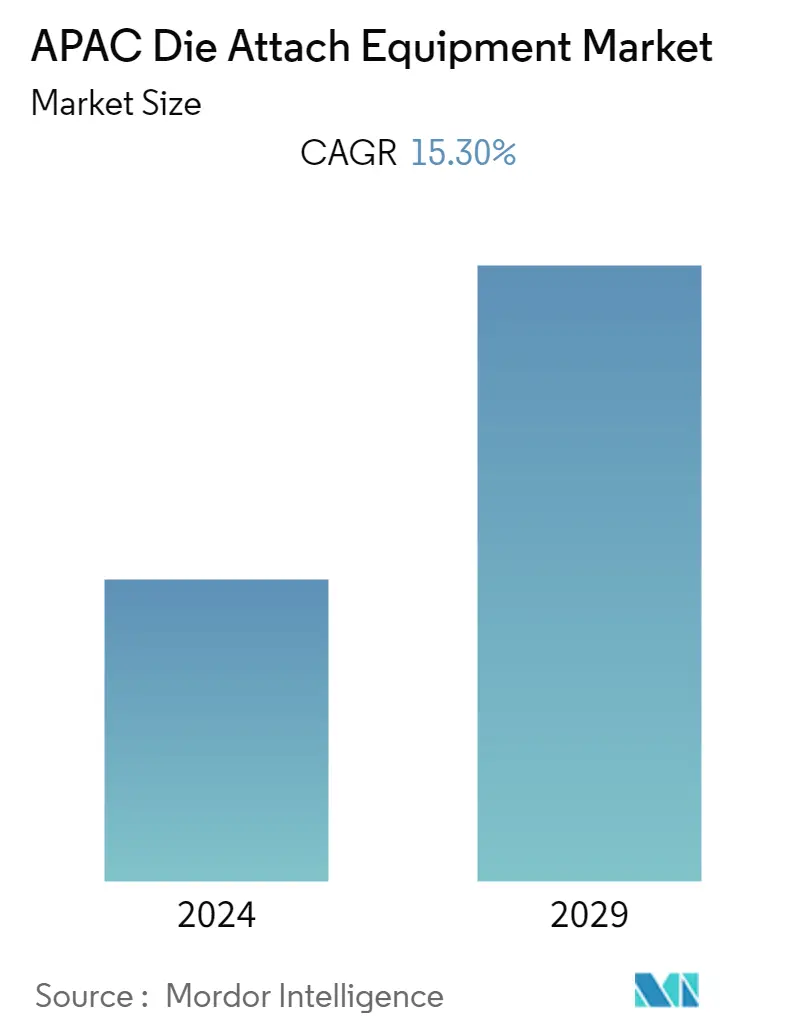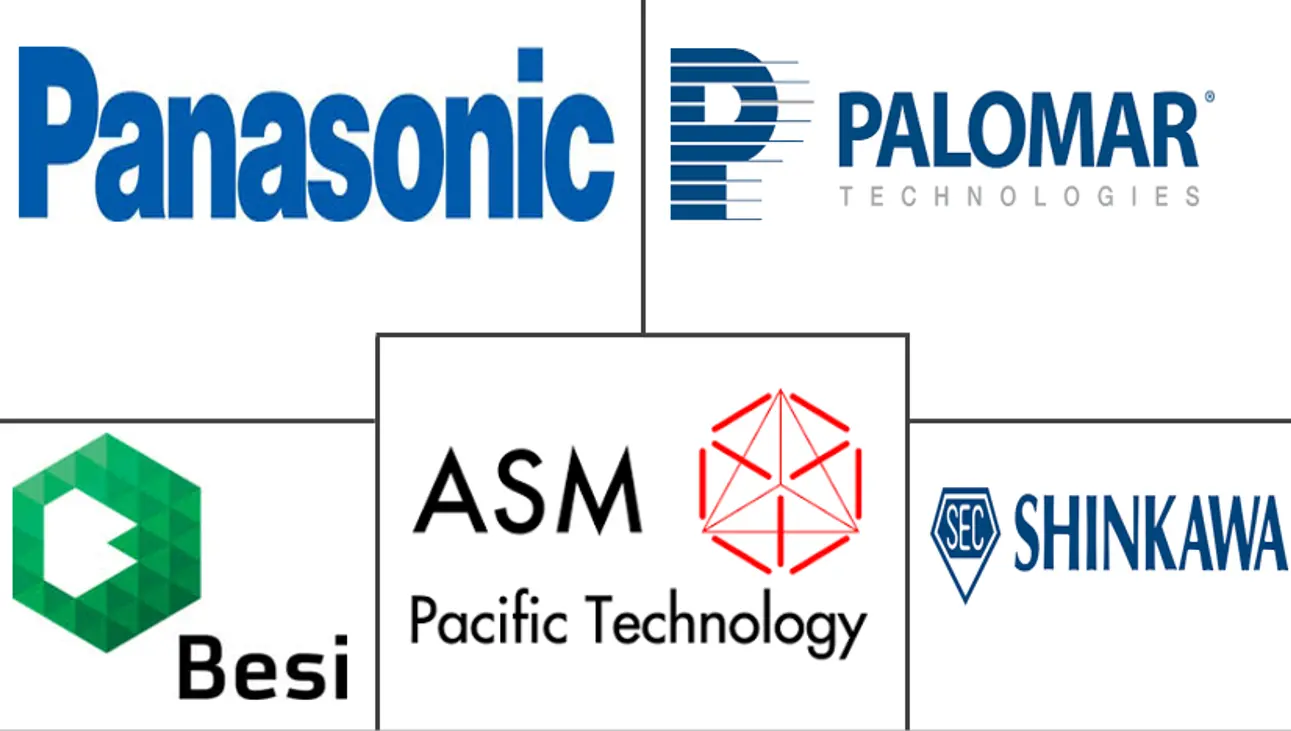Market Size of APAC Die Attach Equipment Industry

| Study Period | 2019 - 2029 |
| Base Year For Estimation | 2023 |
| Forecast Data Period | 2024 - 2029 |
| Historical Data Period | 2019 - 2022 |
| CAGR | 15.30 % |
| Market Concentration | Medium |
Major Players
*Disclaimer: Major Players sorted in no particular order |
APAC Die Attach Equipment Market Analysis
The Die attach equipment market is expected to register a CAGR of 15.3% over the forecast period. The market is expected to benefit from assembly and packaging opportunities created by the below-mentioned trends.
- A significant focus for the next investment round by market vendors is developing die bonding and packaging solutions for smaller and highly complex 5G compatible smartphones. 5G is a unifying connectivity platform for future innovation, enabling continuous secure cloud access at significantly higher data and video transmission speeds.
- User adoption of 5G capabilities expands mobile broadband activities and accelerates artificial intelligence usage for the Internet of Everything. Likewise, the substrate and wafer-level packaging processes for mobile internet, computing, 5G, and automotive end-user applications drove the semiconductor industry to see a recovery in capital investment for memories and logic.
- The company has shared plans for a medium-to-long-term increase in capital investment towards expanded semiconductor and FPD applications. Whereas, as per Shibaura, active development of high-speed, high-precision bonding equipment for FOWLP / PLP and μLED is being looked out for in semiconductor assembly equipment.
- BESI has shared plans to invest in new assembly technologies such as FOWLP, TCB, TSV, ultra-thin dies, hybrid bonding, large area, wafer level molding, solar, and 3D-lithium-ion battery plating for the new digital society. Its lineup under Die attach equipment includes a single chip, multi-chip, multi-module, flip chip, TCB, FOWLP, hybrid die bonding systems, and die sorting systems.
- However, one source of concern is the continuing uncertain outlook due to the impact of the global spread of COVID-19. Lockdowns and production halts across Asia-pacific due to the COVID-19 outbreak had significantly impacted the production and consumption of semiconductors. With the majority of the IDS and foundries located in the region, the impact of shutdowns has led to reduced spending on capital investments. This is likely to impact the market studied, with a slowed recovery expected across 2021.
APAC Die Attach Equipment Industry Segmentation
Die attach is a crucial process in semiconductor packaging. It covers all devices across various applications and contributes to assembly costs. Die bonding is a manufacturing process used in the packaging of semiconductors. It is the act of attaching a die (or chip) to a substrate or package by epoxy or solder, also known as die placement or die attach.
The market is segmented by Technique (Die bonder(Epoxy/Adhesive, Eutectic, Solder, Sintering), Flip chip bonder(Pick and Place/reflow soldering, Thermocompression, Thermosonic Bonding, Hybrid Bonding)), Application (Memory, LED, Logic, CMOS Image Sensor(CIS), Optoelectronics/Photonics, Discrete Power Devices, MEMS & Sensors, Stacked Memory & RF), and Country (Taiwan, China, Japan, Korea, Southeast Asia).
| By Bonding Technique | ||||||
| ||||||
|
| Application | |
| Memory | |
| LED | |
| Logic | |
| CMOS Image Sensor | |
| Optoelectronics / Photonics | |
| Discrete Power Devices | |
| MEMS & Sensors | |
| Stacked Memory & RF |
| Country | |
| Taiwan | |
| China | |
| Japan | |
| Korea | |
| Southeast Asia |
APAC Die Attach Equipment Market Size Summary
The Asia-Pacific die attach equipment market is poised for significant growth, driven by the increasing demand for advanced semiconductor packaging solutions. This growth is largely attributed to the rising adoption of 5G technology, which necessitates the development of smaller and more complex die bonding and packaging solutions. The market is witnessing a surge in capital investments aimed at enhancing semiconductor and flat panel display applications. Companies are focusing on innovative assembly technologies such as fan-out wafer-level packaging (FOWLP), through-silicon vias (TSVs), and hybrid bonding systems to meet the evolving demands of the digital society. These advancements are crucial for supporting the burgeoning mobile broadband activities and the integration of artificial intelligence in the Internet of Everything.
The market landscape is characterized by moderate competition, with numerous players striving to maintain their market share through continuous innovation and strategic partnerships. The demand for die attach equipment is further bolstered by the growing penetration of LEDs, which require reliable and efficient die-attach materials. Conductive adhesives, particularly silver-filled epoxies, are gaining traction due to their compatibility with existing packaging equipment and favorable cost-performance ratio. Key industry players are actively investing in new technologies and equipment to enhance their capabilities in the semiconductor packaging sector. Despite the challenges posed by the COVID-19 pandemic, which temporarily disrupted production and capital investments, the market is expected to recover and continue its upward trajectory, supported by ongoing technological advancements and increasing demand across various applications.
APAC Die Attach Equipment Market Size - Table of Contents
-
1. MARKET DYNAMICS
-
1.1 Market Overview
-
1.2 Industry Attractiveness - Porter's Five Forces Analysis
-
1.2.1 Bargaining Power of Suppliers
-
1.2.2 Bargaining Power of Buyers
-
1.2.3 Threat of New Entrants
-
1.2.4 Threat of Substitutes
-
1.2.5 Intensity of Competitive Rivalry
-
-
1.3 Industry Value Chain Analysis
-
1.4 Impact of Covid-19 on the market
-
-
2. MARKET SEGMENTATION
-
2.1 By Bonding Technique
-
2.1.1 Die Bonder
-
2.1.1.1 Epoxy/Adhesive (paste/film)
-
2.1.1.2 Eutectic
-
2.1.1.3 Solder
-
2.1.1.4 Sintering
-
-
2.1.2 Flip Chip Bonder
-
2.1.2.1 Pick and Place / reflow soldering
-
2.1.2.2 Thermocompresion (TCB)
-
2.1.2.3 Thermosonic Bonding
-
2.1.2.4 Hybrid Bonding
-
-
-
2.2 Application
-
2.2.1 Memory
-
2.2.2 LED
-
2.2.3 Logic
-
2.2.4 CMOS Image Sensor
-
2.2.5 Optoelectronics / Photonics
-
2.2.6 Discrete Power Devices
-
2.2.7 MEMS & Sensors
-
2.2.8 Stacked Memory & RF
-
-
2.3 Country
-
2.3.1 Taiwan
-
2.3.2 China
-
2.3.3 Japan
-
2.3.4 Korea
-
2.3.5 Southeast Asia
-
-
APAC Die Attach Equipment Market Size FAQs
What is the current APAC Die Attach Equipment Market size?
The APAC Die Attach Equipment Market is projected to register a CAGR of 15.30% during the forecast period (2024-2029)
Who are the key players in APAC Die Attach Equipment Market?
Palomar Technologies, Inc., Shinkawa Ltd., Panasonic Corporation, ASM Pacific Technology Limited and Be Semiconductor Industries N.V. are the major companies operating in the APAC Die Attach Equipment Market.

